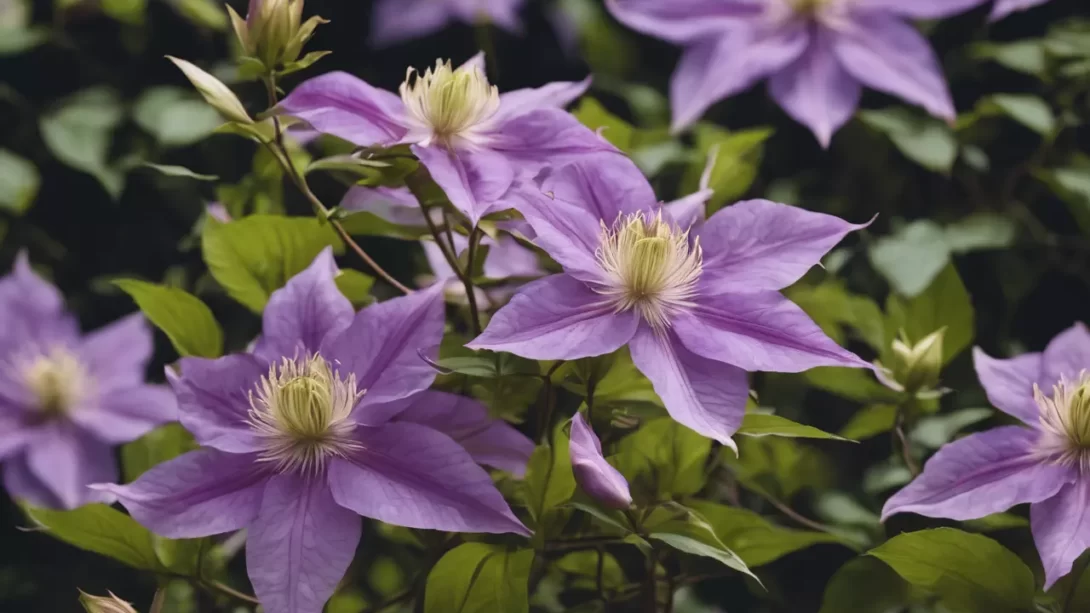Clematis, known for its vibrant blooms and versatile climbing nature, is a favorite among gardeners. While it’s a relatively hardy plant, there are times when transplanting is necessary, whether it’s due to garden redesign, poor growth, or moving plants to a new location. This article aims to provide gardeners with detailed guidance on the best practices and timing for transplanting clematis to ensure its continued health and beauty.
Clematis
Clematis is a genus of predominantly climbing plants, famous for their diverse range of flower colors and forms. They can be deciduous or evergreen and vary greatly in size and growth habit. Transplanting is sometimes essential for clematis, especially if they are not thriving in their current location or if they need more space to grow. Proper understanding of the plant’s requirements and growth patterns is key to a successful transplant.
Best Time to Transplant Clematis
The ideal time to transplant clematis largely depends on the plant’s growth cycle and the local climate:
- General Rule: The best time to transplant clematis is in the early spring or early fall. These periods allow the plant to establish itself in its new location without the stress of extreme temperatures.
- Considerations for Different Varieties: Some varieties of clematis have specific growth and blooming cycles that might influence the best time for transplanting. For instance, early-flowering varieties might be best transplanted in fall, while late-flowering types may prefer spring.
Preparing for Transplantation
Before moving a clematis, several preparation steps should be taken:
- Plant Health Assessment: Ensure the plant is healthy enough to withstand the move. If it is showing signs of disease or severe stress, it may not survive the transplant.
- Choosing a New Location: Clematis thrive in well-drained soil with access to full sun or partial shade. The new location should meet these requirements for optimal growth.
- Site Preparation: The new planting site should be prepared ahead of time. Amend the soil with compost to provide nutrients and improve drainage.
The Transplanting Process
Transplanting a clematis requires careful handling to minimize stress and shock to the plant. Follow these steps for a successful transplant:
- Watering Before Transplant: Water the clematis thoroughly a day before transplanting. This helps to ensure that the roots are well-hydrated.
- Root Ball Preparation: Dig around the base of the clematis to create a large root ball. The goal is to preserve as many roots as possible. Gently lift the plant, keeping the root ball intact.
- Moving the Plant: Transport the clematis to its new location carefully. It’s best to move it as quickly as possible to minimize the time the roots are exposed to air.
- Replanting: Plant the clematis at the same depth it was growing before. Fill in around the root ball with soil, gently firming it down. Water the plant well after transplanting.
Aftercare for Transplanted Clematis
Proper care after transplanting is crucial for the clematis to establish itself in the new location:
- Watering: Keep the soil consistently moist for the first few weeks after transplanting. This helps the clematis recover from transplant shock and encourages root growth.
- Mulching: Apply a layer of mulch around the base of the plant to help retain moisture and regulate soil temperature.
- Fertilizing: Wait until the clematis shows signs of new growth before applying a balanced fertilizer. Over-fertilizing immediately after transplanting can stress the plant.
- Pruning: Pruning may be necessary to remove any damaged or dead stems. This also encourages the plant to focus its energy on establishing new roots.
Common Challenges in Transplanting Clematis
Transplanting clematis can sometimes be tricky, with a few common challenges:
- Transplant Shock: Symptoms include wilting and leaf drop. Ensuring minimal root disturbance and adequate watering can help mitigate this.
- Root Damage: Be extra cautious to avoid damaging the roots during the transplant. Damaged roots can lead to poor growth or even plant death.
- Adjustment Period: It may take some time for the clematis to adjust to its new location. Be patient and provide consistent care as the plant settles in.
Conclusion
Transplanting clematis can be a delicate process, but with careful planning and execution, it can lead to renewed growth and vigor of these beautiful climbing plants. Remember, the key to a successful transplant lies in timing, minimal disturbance to the roots, and providing the right aftercare.
Choosing the correct time, either early spring or early fall, is crucial to give your clematis the best chance to establish itself in its new location. Preparing both the plant and the new site beforehand will ease the transition for your clematis. During the transplant, handle the root ball gently to minimize damage and stress to the plant.
After the move, consistent watering, proper mulching, and avoiding over-fertilization are vital steps to help your clematis recover and thrive. While it may take some time for the plant to fully adjust and return to its former glory, patience and careful monitoring during this period are key.
Dealing with potential transplant shock and other challenges effectively will ensure that your clematis continues to be a stunning feature in your garden. With the right care, these climbers will grace your garden with their beautiful blooms for many seasons to come.
In conclusion, while transplanting clematis requires effort and attention, the results can be highly rewarding. Successfully relocated clematis will not only enhance the beauty of your garden but also offer a sense of accomplishment in seeing them flourish year after year. Whether you’re an experienced gardener or a beginner, the joy of nurturing these plants through a successful transplant is a fulfilling aspect of gardening in any setting.



